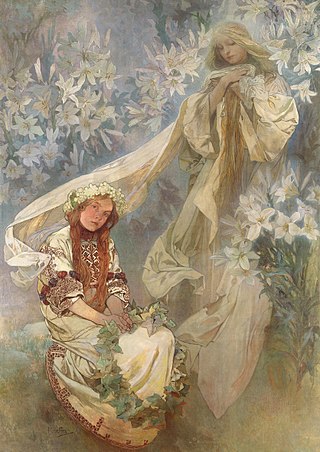
Chloe, also spelled Chloë, Chlöe, or Chloé, is a feminine name meaning "blooming" or "fertility" in Greek. The name ultimately derives, through Greek, from the Proto-Indo-European root *ǵʰelh₃-, which relates to the colors yellow and green. The common scientific prefix chloro- derives from the same Greek root. In Greek the word refers to the young, green foliage or shoots of plants in spring.
Betty or Bettie is a name, a common diminutive for the names Bethany and Elizabeth. In Latin America, it is also a common diminutive for the given name Beatriz, the Spanish and Portuguese form of the Latin name Beatrix and the English name Beatrice. In the 17th and 18th centuries, it was more often a diminutive of Bethia.
Amy is a female given name, sometimes short for Amanda, Amelia, Amélie, or Amita. In French, the name is spelled "Aimée".
Melanie is a feminine given name derived from the Greek μελανία (melania), "blackness" and that from μέλας (melas), meaning "dark". Borne in its Latin form by two saints, Melania the Elder and her granddaughter Melania the Younger, the name was introduced to England by the Normans in its French form Melanie. However, the name only became common in English usage in the 1930s because of the popularity of Margaret Mitchell's 1936 novel Gone with the Wind and its 1939 film adaptation, as one of the novel's main characters was named Melanie Hamilton. The name's popularity increased until the 1970s, since remaining constant. Melanie was the 80th most popular name for girls born in the United States in 1957 and, as Mélanie, it was the 86th most popular name for girls born in France in 2004.
Aubrey is traditionally a male English given name. The name is from the French derivation Aubry of the Germanic given name Alberic / Old High German given name Alberich, which consists of the elements ALF "elf" and RIK "king", from Proto-Germanic *albiz "elf", "supernatural being" and *rīkaz "chieftain", "ruler". Before the Norman conquest, the Anglo-Saxons used the corresponding variant Ælf-rīc.
Katie is an English feminine name. It is a form Katherine, Kate, Caitlin, Kathleen, Katey and their related forms. It is frequently used on its own.
Samantha is primarily used as a feminine given name. It was recorded in England in 1633 in Newton Regis, Warwickshire. It was also recorded in the 18th century in New England, but its etymology is uncertain. Speculation has suggested an origin from the masculine given name Samuel and anthos, the Greek word for "flower". One theory is that it was a feminine form of Samuel to which the already existing feminine name Anthea was added.
Esmé or Esmée, including Esmee is an English first name, from the past participle of the Old French verb esmer, "to esteem", thus signifying "esteemed". Another theory is that esmer is an alternative spelling of today's aimer, "to love", thus the name is aimé, meaning "beloved", equivalent to the modern feminine first name "Amy". Originally a masculine name, Esme had become a feminine name by the mid-twentieth century.

Eva is a female given name, the Latinate counterpart of English Eve, derived from a Hebrew name meaning "life" or "living one". It can also mean full of life or mother of life. It is the standard biblical form of Eve in many European languages.

Renée is a French/Latin feminine given name.

Robin is a unisex given name and a surname. It was originally a diminutive masculine given name or nickname of Robert, derived from the prefix Ro-, and the suffix -in. In Europe, although it is sometimes regarded as a feminine name, it is generally given to boys. In 2014, 88% of babies named Robin in England were boys. In United States, it used to be more popular as a feminine name—during the 1990s, for example, it was the 325th most popular name for girls and the 693rd most popular name for boys. However the gap has been narrowing and recently the number of baby boys and baby girls named Robin in United States has been roughly similar. In 2014 46% of babies named Robin in United States were boys, which is about three times that figure in 1990.
Megan is a Welsh feminine given name, originally a diminutive form of Margaret. Margaret is from the Greek μαργαρίτης (margarítēs), Latin margarīta, "pearl". Megan is one of the most popular Welsh-language names for women in Wales and England, and is commonly truncated to Meg.
Ashley is a given name which was originally an Old English surname. It is derived from the Old English (Anglo-Saxon) words æsc (ash) and lēah and translates to "Dweller near the ash tree meadow".
Cassie is a feminine given name and a short form of various other given names mostly used in English-speaking countries. It is more rarely a surname. People and fictional characters named Cassie include:
Cross is an English topographic surname for someone who lived on a road near a stone cross.
Rosie is a feminine given name of English origin. It is a diminutive form of the English language given name Rose, which is of Latin origin. Similar diminutives in other languages include: Rosa becoming Rosita in Spanish, and Ruža becoming Ružica in Slavic languages. Rosie is a nickname for variations of "Rose" such as "Rosalie", "Rosemary", "Roseanne", "Rosalyn", “Rosanna”, and more.

Lily is a feminine given name usually derived from lily, the flower. The name became particularly popular along with other flower names for girls during the 1800s and early 1900s. The lily also has associations with and has been symbolic of innocence and purity in Christian art. Names beginning with or containing the letter L have also been particularly fashionable for girls. It is also occasionally used as a diminutive for other names such as Elizabeth.

Stephanie is a female name that comes from the Greek name Στέφανος (Stephanos) meaning "crown". The male form is Stephen. Forms of Stephanie in other languages include the German "Stefanie", the Italian, Czech, Polish, and Russian "Stefania", the Portuguese Estefânia, and the Spanish Estefanía. The form Stéphanie is from the French language, but Stephanie is now widely used both in English- and Spanish-speaking cultures.
Kim is a male and female unisex given name. It is also used as a diminutive or nickname for names such as Kimber, Kimberly, Kimberley, Kimball and Kimiko. In Kenya it is short for various male names such as Kimutai and Kimani. In Vietnam it is also a unisex name.
The given name Lisa can be a short form of Elisabeth, Melissa or Elizabeth. In the United Kingdom, the name Lisa began to gain popularity during the 1960s, by 1974 it was the fifth most popular female name there, and a decade later it was the 14th most popular female name there. However, by 1996 it had fallen out of the top 100. Similarly, in the US it was the most popular female name for most of the 1960s and in the top 10 through most of the 1970s before falling.






